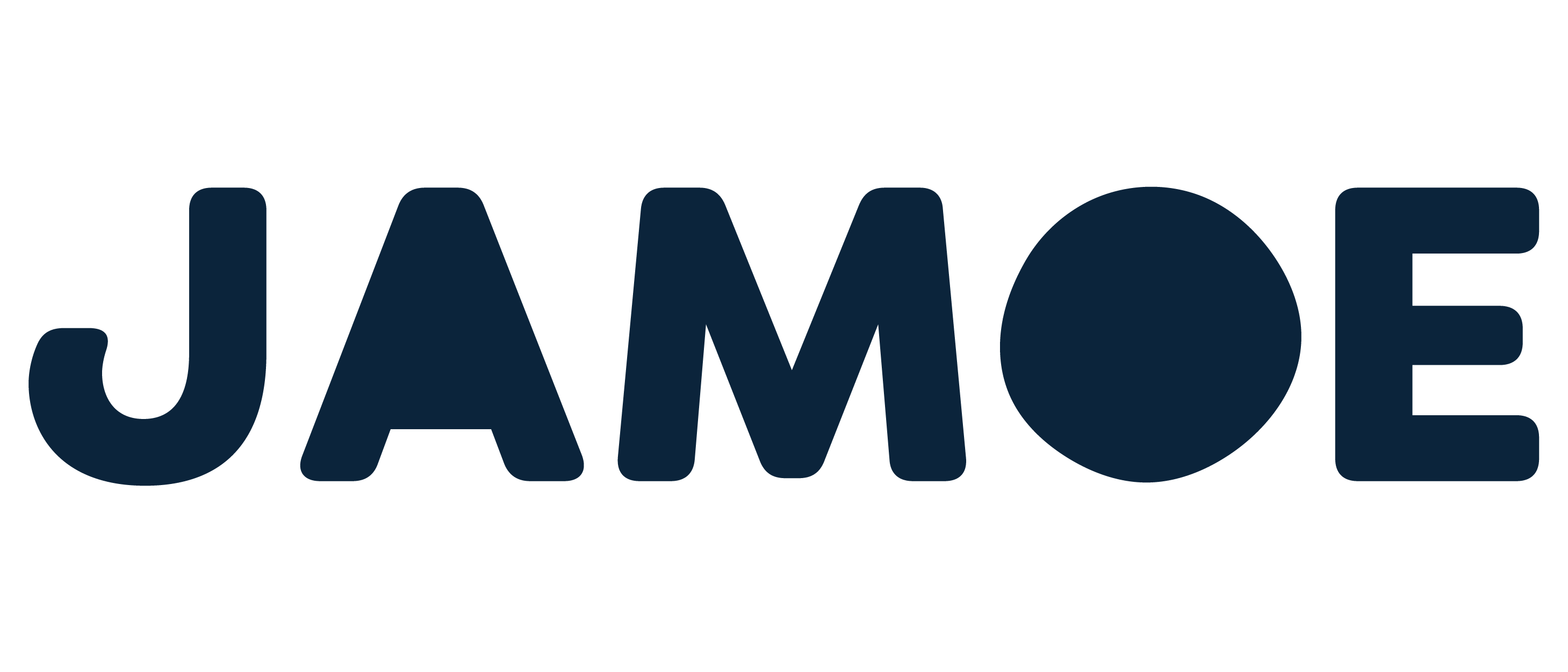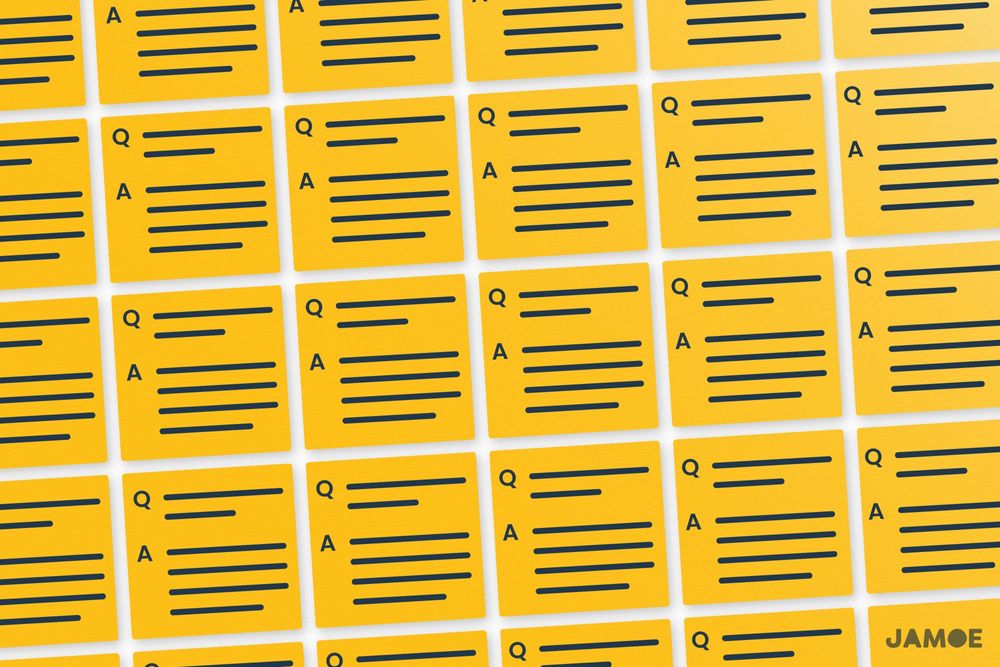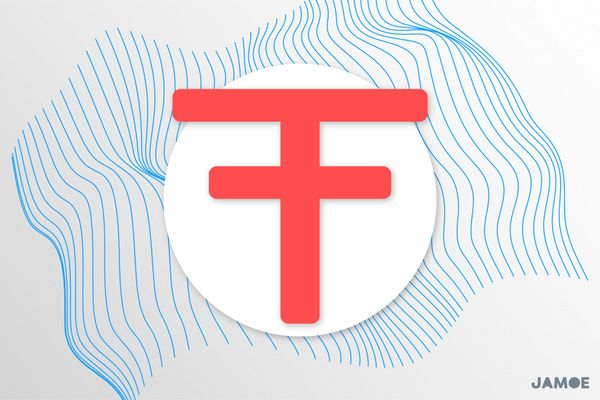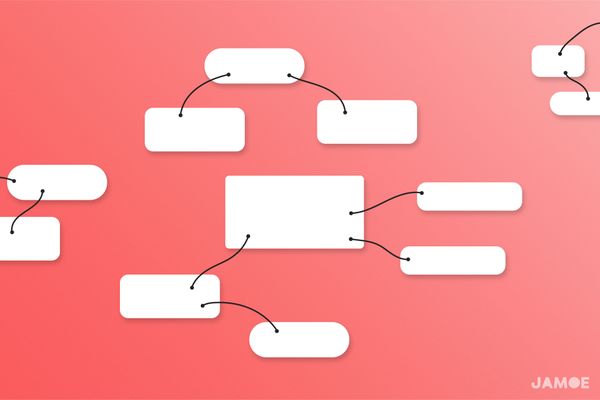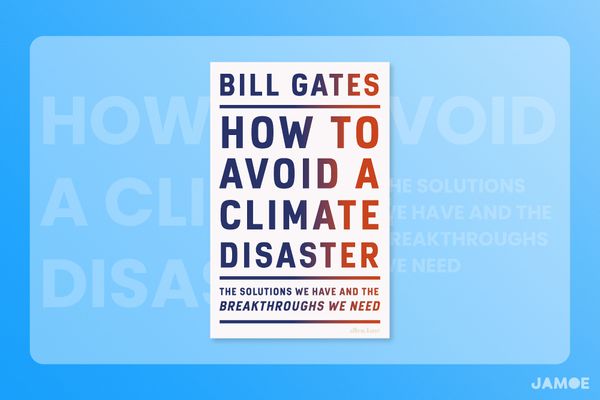Get More Value and Joy from Books with Handwritten HQ&A Notes (Pt 2)
This is part two in our note-taking series.
At a glance
- Become aware of how digital note-taking promotes shallow thinking when reading physical non-fiction books, so you can approach your reading more thoughtfully and joyously. You'll also find you can understand, retain and apply what you're reading more effectively over the long term.
- Unchain yourself from your computer. Test drive our recipe for taking effective handwritten HQ&A Notes using pen and paper or the Post-It note variation.
Introduction
Taking notes on physical non-fiction books is best done by hand. While there's evidence to support we remember handwritten notes best, that's not why we recommend it[1].
First, sitting at a computer desk while reading is uncomfortable. Second, computers offer us thousands of functions, including thousands of temptations and disruptions. Paper is the opposite. It nudges you to focus and think deeper when reading, as there's nowhere else to spread your attention.
Before that, it's worth checking that the note-taking technique aligns with your goals. Being the knife in our knife and fork note-taking toolkit, the HQ&A technique is for when narrow depth is a priority. That is, you're reading something that is honestly worth distilling and understanding on a deeper level for the sake of your studies, work, or intellectual curiosity.
If you need something faster, as you're just learning a topic, or because slowing down to take thoughtful notes isn't preferable or practical, then our Jump Notes technique will be a better fit.
We'll provide an abridged recap of the HQ&A note-taking technique below, but if you'd like a full refresher, please see the debut article on the topic: HQ&A: Take Better Notes When Reading Non-Fiction.
For illustration purposes, we'll be featuring the notes we took while reading Bill Gates' 2021 book, How to Avoid a Climate Disaster.
What does the result look like?
Let's start with the result and work backwards. Below you'll see a sample of the handwritten notes we took while reading Gates' book on avoiding climate disaster.
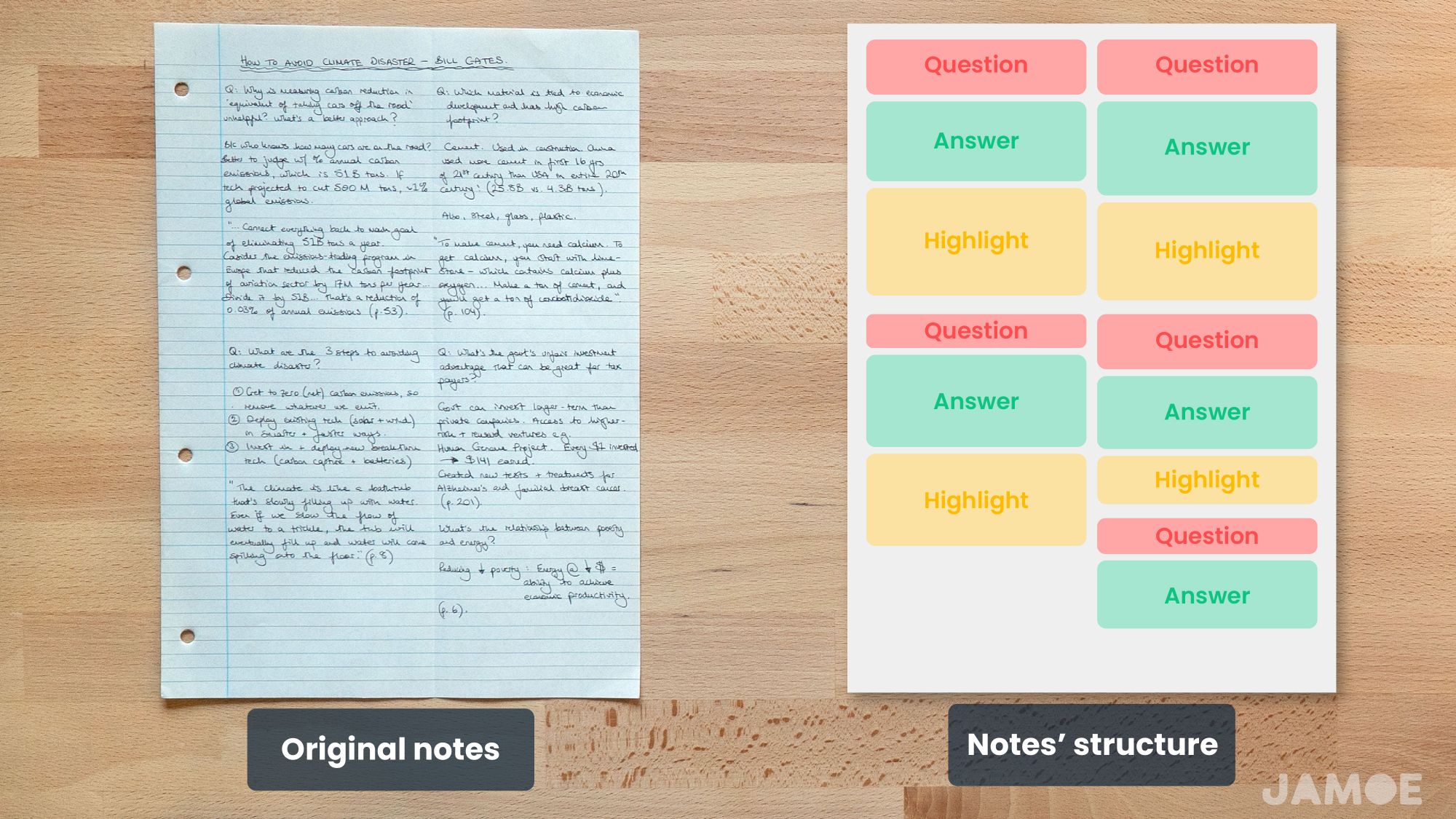
Focus your attention on the right. The graphic shows the high-level structure of our notes. Before we offer more context, one of the key benefits of this approach is clear: reviewing your notes in this format is as quick as a hungry caterpillar through lettuce.
Each note is a distinct building block representing the ideas and insights that resonated with us. When reviewing our notes, either to write something based on its argument or to recall the insights, all of the most significant points are waiting for us. That makes the review process much faster, as we can easily skim the questions and dive into the details as needed.
Take this example. Say we're going through our notes, and we want to know the best way to prioritise which carbon reduction technologies we should be investing in. Glancing over our questions, we can quickly find a note that fits:
Question: Why is measuring carbon reduction in 'equivalent to taking one car off the road' unhelpful? What's a better approach?
Questions are shorter than summaries. That makes finding a relevant note much faster. The added benefit is that the Question prompts you to recall and remember the insights from the text. That helps fight forgetfulness per the Spaced Repetition Technique.
When we've found a Question that's a strong fit, we'll read our Answer. If we need more context, we'll also read the original Highlight we took from the text:
Answer: Because who knows how many cars are on the road? Better to judge every carbon reducing initiative as a % of carbon emissions, which is 51 billion tons. So, if a technology is projected to cut 500 million tons that's ~1% of global emissions.
Highlight: '...Connect everything back to the main goal of eliminating 51 billion tons of year. Consider the emissions-trading program in Europe that reduced the carbon footprint of the aviation section by 17 million tons per year... Divide it by 51 billion... that's a reduction of 0.03% of annual global emissions.' p.53
With this approach, your note-taking technique is working for you rather than against you.
Its design allows you to jump between moving fast and slow through your notes and has the benefits of active recall built-in, making your memories stickier.
Workflow for taking handwritten HQ&A Notes
With a clear view of what you'll end up with and how it's designed to make review and recall efficient, let's unpack the workflow for taking a handwritten HQ&A note.
Equipment-wise, you don't need anything fancier than a pen and some paper:
- Divide your paper into two columns: we do this without a ruler. Instead, we just hold our paper in portrait and fold it in half. Columns are more skimmable, making reviewing your notes later easier. The narrow width will also make you more precise with your word choice. Precise word choice is precise thinking.
- Write your Question first: when reading, an insight might catch your attention. Your Highlight is the part of the text that best captures that insight or is a quote you want to reference later. However, think of a precise Question for which the Highlight is the answer. That will force you to apply the new idea, and it is the difference between knowledge and understanding. Thinking of an effective connecting Question is a mental workout, so it may take some time, but that's a sign you're digesting what you're reading.
- Write your Answer: write, in your own words, the answer to your Question. This should be a crisp summary future-you will appreciate it when you come to review and recall your notes.
- Write your Highlight: write down the excerpt from the text and the page number. By writing this last, it'll put your insights at the top of every note and the additional context at the bottom. That makes reviewing your notes faster per the above example.
As you repeat this process, you'll end up with bitesize blocks of the best ideas and insights from the text. That's why the HQ&A technique is the knife in our knife and fork note-taking toolkit: with it, you can carve up even the toughest concepts in what you're reading.
The bonus is that every note represents your own thoughts on the author's ideas, and you'll be able to steer clear of the pitfall of copying rather than comprehending what the author is saying.
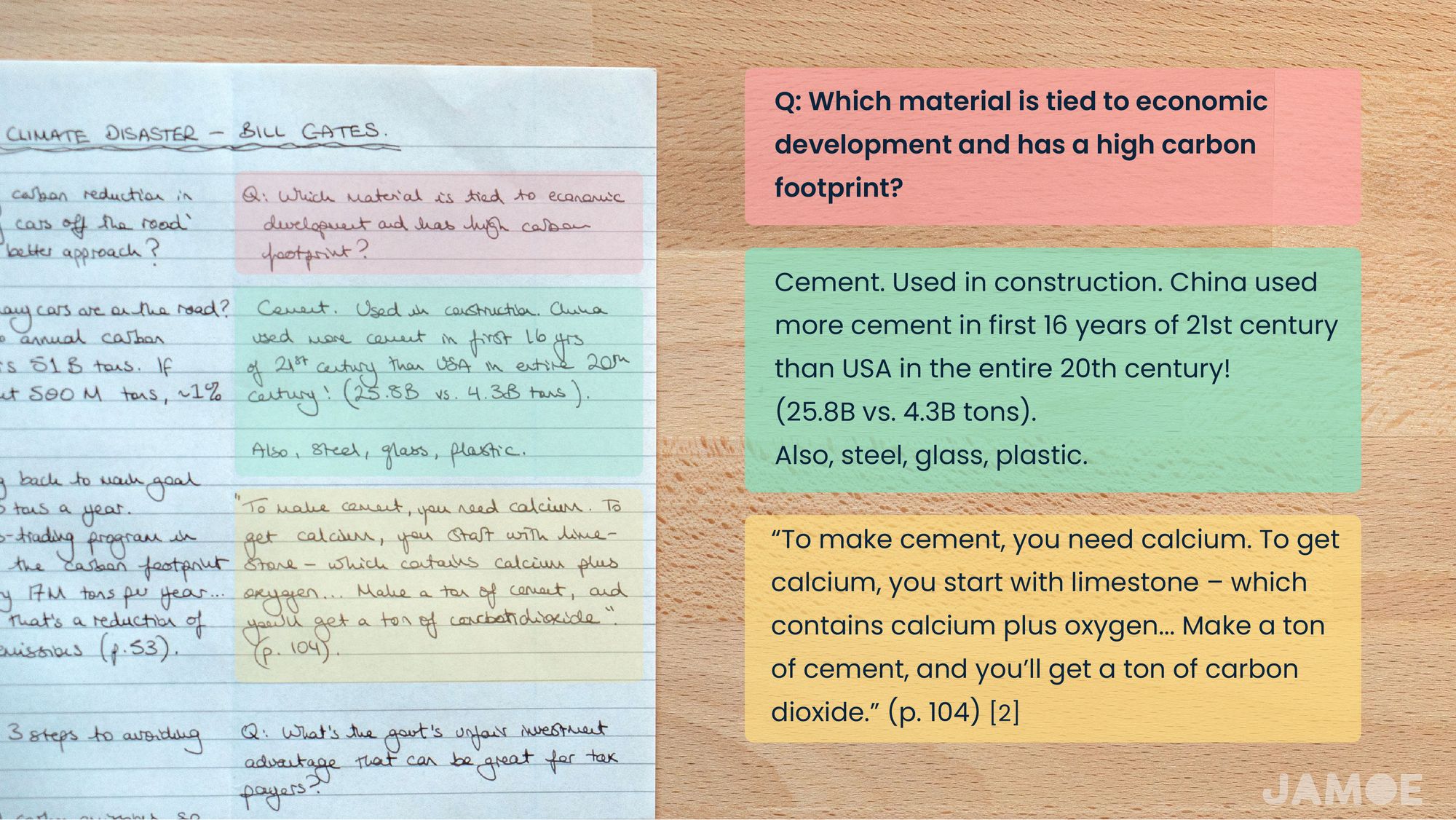
Balancing joy and effort when taking notes
Taking notes when reading can ruin your flow. Sometimes you just want to get through a text or be carried away by the author's lyrical prose. That's part of the joy of reading.
However, you're also reading to squeeze out some of the book's goodness and store it for the future. That's the effort of note-taking, and it'll help you become a deeper and more original thinker over the long run.
This balance between joy and effort means finding your place between these two extremes:
- (Joy) The best stuff will stick – take notes on nothing.
- (Effort) Forget nothing – take notes on everything.
Depending on how comfortable you are with the material you're reading and how much time you have, the HQ&A technique may be too effortful. If that's the case, we recommend switching over to our more joyful thinking fast note-taking technique: Jump Notes.
If the HQ&A technique is the right fit for your needs and you're comfortable using it, there are a couple of tweaks you can make to strike a more sustainable balance between joy and effort. The first is practical; the second is philosophical.
Don't write out the Highlight
Copying out the Highlight is time-consuming. That's why we run a mental check beforehand to see if it's worth it. If both conditions are true, then we recommend skipping this step:
- When it feels more like a chore than something that adds value.
- When skipping the Highlight doesn't cut out any important context, we'll need to make the note useful later, e.g. a statistic we want to reference.
Other times when you'll not want to skip the Highlight include when you want to capture phrasing that is particularly novel or beautiful[3]. Another is if you're borrowing the book from a library or a friend. You won't be able to easily return to the original text, so writing down the Highlight will serve as your own small copy of the author's brain.
Honest Productivity Principles when note-taking
As written about in the debut HQ&A article, our Honest Productivity Principles also serve as a valuable compass for prioritising quality over quantity:
- Focus on what matters: simple to the point of almost being insulting, but don't take notes on everything you consume. Instead, have a strong filter for prioritising. Our filter is that whatever we're consuming must help us move forward with some goal that matters.
- Achieve more with less: when reading, look for the note that captures 80% of the value but is only 20% of the effort. Often non-fiction is repetitive, padded, or gives examples to ensure you get it. But, once you've got it, you can compress the idea, so it occupies a much smaller space.
- Work sustainably: if you haven't taken a note for a while, check to see you're still concentrating. Usually, this happens when we're tired, so we'll take a break, as carrying on will only give us the illusion of progress.
The Post-It Note Variation
This is our personal sweet spot between joy and effort when using the HQ&A technique. We've left this for last, as you don't need to use Post-It Notes to get value from the HQ&A technique, but you may want to consider using them at some point.
By writing our HQ&A Notes on Post-Its and then placing them on the relevant pages, we end up with a book that's full of shortcuts to the main ideas and insights we care about.
As Post-Its are small, they force us to focus our notes on what's important. Then we need to compose the note thoughtfully to ensure that the compressed idea still makes sense. That includes potentially peppering in a few helpful diagrams.
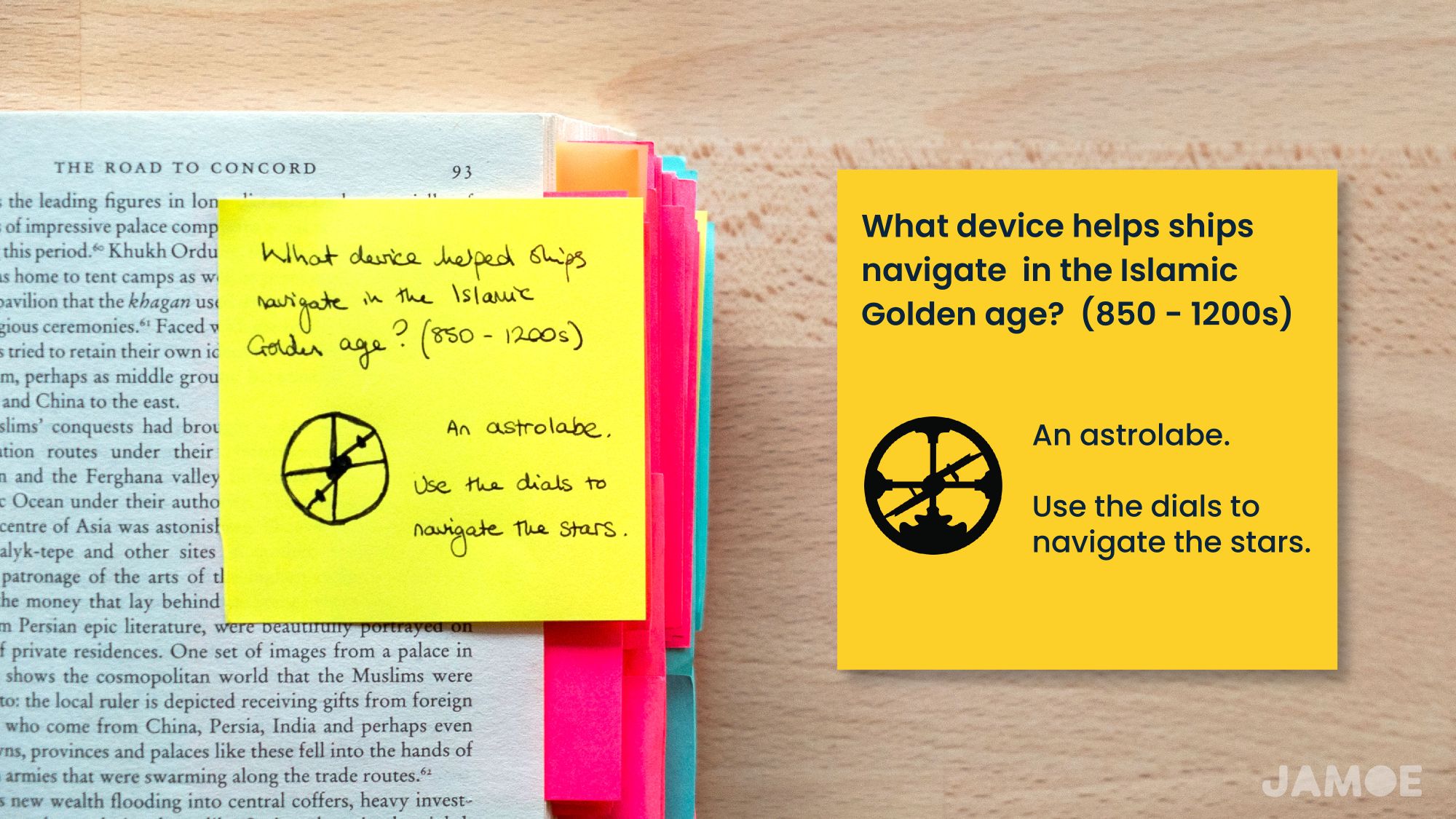
If we ever need to re-read the original context, we can look under the Post-It by lifting it off the page. That spares us copying out the Highlight. Wanting to avoid tearing any pages, we also touch the sticky edge of the Post-It on our jeans before placing it down to dampen the stickiness.
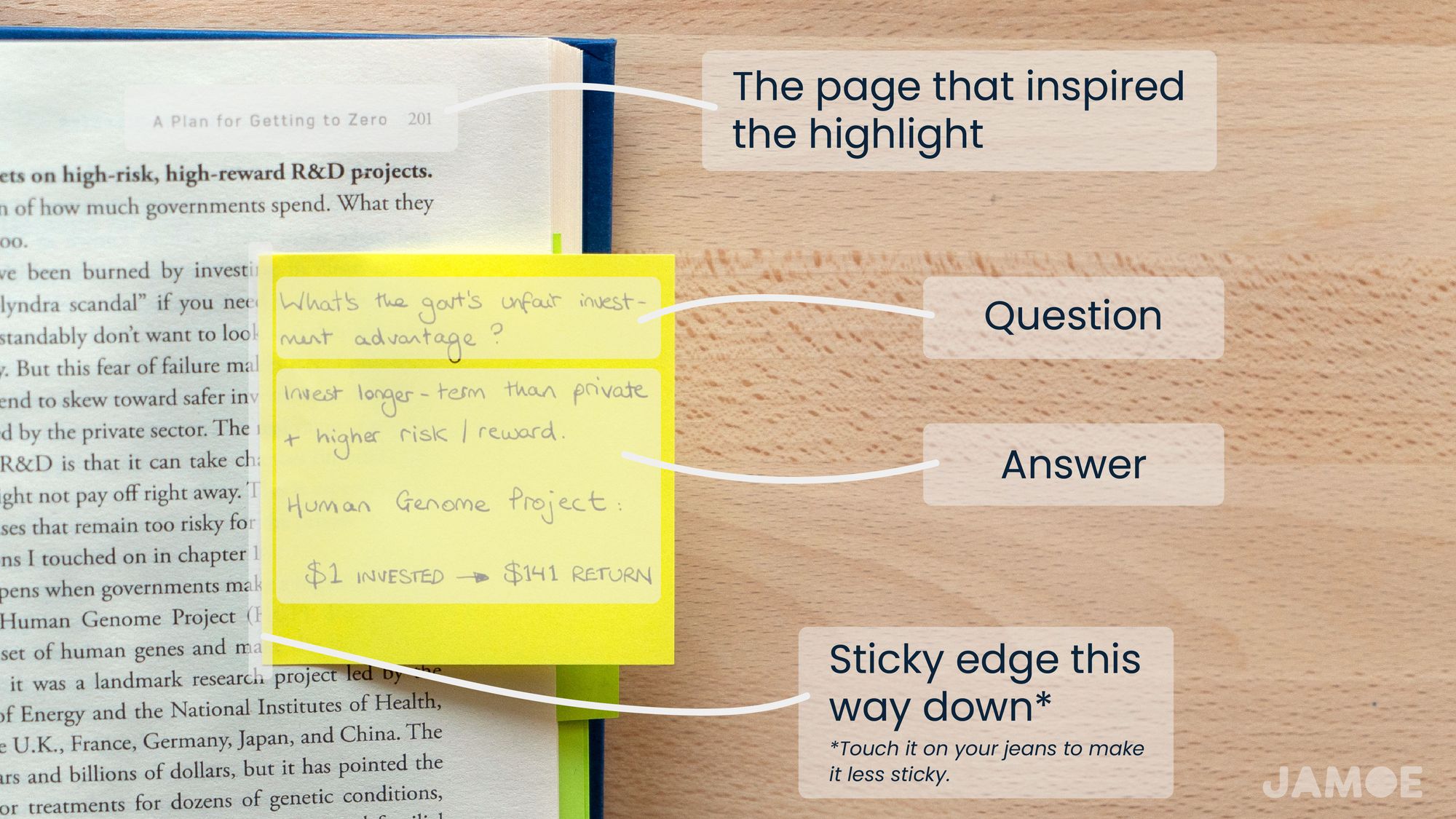
Tweaking our handwritten notes workflow in this way has transformed our bookshelves, as our notes and our books now live together. This feeds two birds with one scone, as visiting one means visiting the other.
Conclusion
When reading physical non-fiction books in this way, you may want to type up your notes. In the interest of balancing time and value, we recommend prioritising your notes and only typing up the ones you want to remix and retain in a digital form.
When prioritising, we ask ourselves, 'Will this note be useful?'. For example, if the notes we've taken on a book will form part of our Spaced Repetition workflow for something we're learning, then we'll type that up. Or, if we want the note to be searchable because it's a great fertiliser for our writing and connects to ideas we've read elsewhere, we'll type that up too.
Time is precious, so rather than capturing everything, we only invest it where we think it’ll help achieve our goals. That's part of Honest Productivity.
For the featured notes taken on Bill Gates’ 2021 book, How to Avoid a Climate Disaster, you can see the bonus article here, and for the next article in our Honest Notes note-taking series, check out Upgrade your HQ&A Notes with Up, Down, and Across (Part Three).
Footnotes
[1] Looking at the literature, there are many credible studies on the advantages of handwritten notes. However, this one published in Psychological Science is the most thought-provoking and instructive. Most studies focus on the distractions of using a computer. This study goes further. It found that even when using a laptop solely for note-taking by eliminating its multi-tasking functions, it still results in an inferior level of understanding and retention compared to those who took their notes by hand: “laptop note takers’ tendency to transcribe lectures verbatim rather than processing information and reframing it in their own words is detrimental to learning”.
[2] For our fellow chemistry fans thinking about the chemical reaction for the oxidation of limestone: CaCO3 → CaO + CO2.
[3] On beautiful language, The Silk Roads by Peter Frankopan features Anna Bijns, a 15th century Flemish poet who campaigned for equal rights, riding the wave of female financial empowerment after the Black Death mowed down the male working population. The change allowed many women to become wage-earners for the first time. Her phrasing in this poem about the woes of marriage is especially striking, "Don't hurtle into marriage too soon... one who earns her board and clothes shouldn't scurry to suffer a man's rod... Through wedlock I do not decry; unyoked is best! Happy the woman without a man!".
Read part three in our note-taking series.
